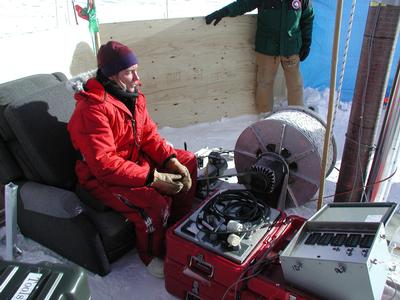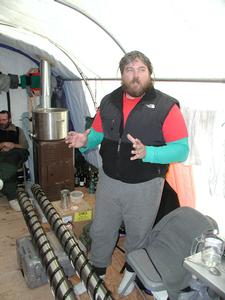30 November, 2001
The low pressure weather system that began passing over the station yesterday is now at its maximum strength. The SPASE shack, normally visible from my dorm window, is not visible. We are approaching what is known as a white out. A white out is caused by strong winds carrying snow across the Antarctic Plateau, reducing visibility to almost zero.
Earlier this morning, I heard a LC-130 plane flying overhead. It was circling the station waiting for the visibility to clear so that it could land. I cannot image how the passangers felt when it was announced that they would have to return to McMurdo.
Another announcement stated that all flights for the day were cancelled. When a flight departing from McMurdo to the South Pole has to return, it is not a problem becuase the plane has enough fuel for the round trip. However, I wondered what happens when planes arrive at McMurdo in white out conditions. They only have an hour of fuel remaining, putting them in a risky situation. A man sitting next to me gave the answer.
Usually when McMurdo is experiencing a white out, the plane will be diverted to other landing strips, such as the one found at the Italian Terra Nova Station. If all of the backup runways are also experiencing a white out, then there is only one option...a blind landing. In these rare circumstances, the plane will fly a few miles out from any land. Then the pilot, unable to see anything but white, will skillfully lower the plane at a very slow rate. The plane will continue to gradually drop in elevation until it touches down on the frozen ocean. Then, they wait for the white out to pass and taxi all the way to the station.
Eventually the conditions improved, but not enough for us to work on our detector. With a few hours to spare, Mats and I were invited by Jerry Martin to visit a remote drilling site five miles away from the station. We immediately accepted the offer.
In order to get to the remote drilling site, we had to ride in a Hagglund vehicle. A Hagglund is simply a four-person vehicle with tank tracks instead of wheels. Traveling in the Hagglund was a unique experience. As we left the confines of the station, and headed into the unprotected Antarctic Plateau, we saw a strange and uninhabited landscape. With visibility reduced to 100 yards, all we saw was flat windswept terrain with snow flowing across the scared ice like rolling fog in a late-night horror flick.
A little more than a half hour after leaving the South Pole Station, we arrived at the remote drilling site. The project being conducted by the five isolated people here is called the South Pole Remote Earth Science Observatory (SPRESO). The goal of SPRESO is to drill three 300 meter holes in the hard ice. Once the holes are drilled, seismographs will installed. Seismographs are instrument that detect earthquakes.
There is a seismograph at the South Pole Station, but the construction of the new station is creating too much noise. The construction noise is making it difficult for the geologist to collect data, thus mandating a new site to be found. The current site that we were visiting was far enough from the station to reduce excessive noise, yet close enough to allow safe operation.
Once the seimographs are in place at the SPRESO site, they will be remotely operated. These seimographs will become part of a global network operated by the United States Geological Survey (USGS). The information obtained from this network of seismographs will allow scientists to monitor earthquakes, study the Earth's interior, and monitor nuclear explosions. It was a similar network of seismograph stations that allowed scientists to determine the exact location of the Russian submarine that exploded and sunk in the North Sea.
Due to the high winds, the drilling had to stop for the day. However, this allowed the staff of the SPRESO site to explain how they drill in solid ice and show us the tents they sleep in. Currently, the drill team had reached 120 meters in depth. Since the cores of ice they had extracted were not being used by any other research projects, they gave us a core of ice that was over 1000 years old.
After visiting the site, we drove a little further to look at an old solar observatory. The observatory contained a few buildings and a tower over 60 feet tall. When we arrived at the site, the only portion of the site still remaining was the tower, of which only 8 feet remained above the snow. Each year, snow carried by the wind accumlates on the Antarctic Plateau burying anything in its path, such as the dome back at the South Pole Station. It is for this reason that a new base is under constuction.
Four hours after departing the station, we safely returned. The visibility had improved, so after a quick dinner we headed back to the SPASE shack to continue working on the detector.
Biological Data
Saturated Oxygen: 94%
Pulse Rate: 88
Weather Data
Temperature: -25.4 F
Windchill: -81.1 F

Lou Albershardt sitting in the driver's chair of the drill.

Drilling head used for drilling through solid ice.

The Hagglund vehicle that transported us to the SPRESO site.

Kent Anderson, a seismologist from the USGS, explaining the SPRESO remote drilling site.

Kent Anderson's tent at the remote drilling site.
Contact the TEA in the field at
.
If you cannot connect through your browser, copy the
TEA's e-mail address in the "To:" line of
your favorite e-mail package.
|
